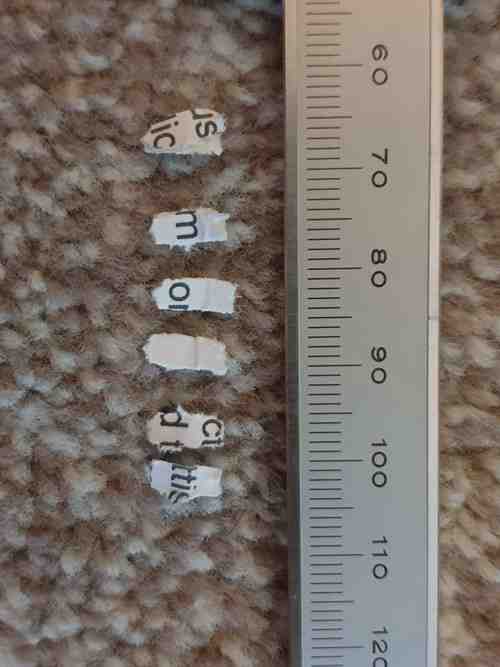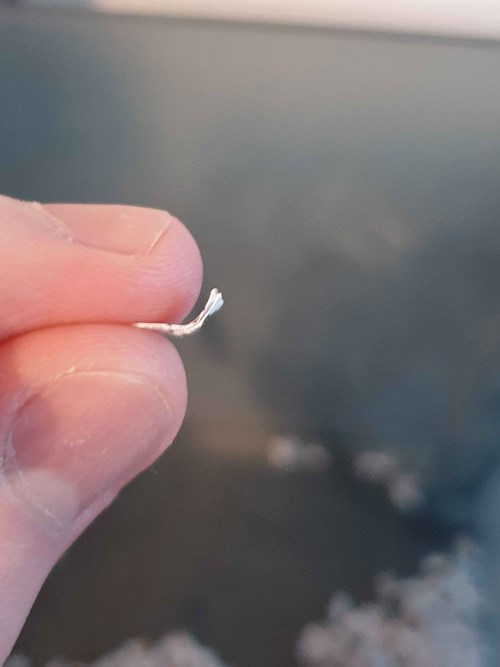I am someone who takes my digital security fairly seriously.
In my house, I have had many documents containing personal information - documents from the government, the council, the bank; misprints of documents I've had to mail off, e.t.c.
With good digital security, you can delete things and they are simply gone, but this luxury is more complex with physical print-outs.
You can buy a shredder of course. The cheap ones tend to cut into strips, which even a toddler could re-assemble into the original form. Not useful.
You can get cross-cut shredders. Looking on Amazon, I see claims on some pages that these cut into strips of 4x50mm, 5x40mm, 5x18mm, and 5x42mm - just by looking at the top few results. I wasn't quite happy with this. Furthermore, all of these machines are pretty big. I'm just a home user who won't be shredding things constantly, so I wanted something more compact that I could stash away when not in use. The benefit to these types of machines is that they can sometimes cut staples, which can be a time saver.
Enter this incredible machine. I know it seems over the top to be talking like this about a shredder of all things, but bare with me.
Specifications
| Dimensions | 213x152x249mm |
| Cable | 160cm non-removable |
| Strip Size | 3x9mm |
| Number of strips per A4 sheet | 2310 |
Duronic advertises a strip size of 3x9mm, and I measured it to check. The strips are not quite rectangular and are more arrow-shaped; I left the caliper loose so that you can see this. When taking a measurement correctly, I agree with 3x9mm.
So the strips are small as advertised. This equates to 2,310 strips per A4 sheet, which is a lot more strips than you would get for the other sizes produced by other machines, assuming they advertise correctly. More strips means better privacy.
Furthermore, the machine is compact, and so is perfect for home use. It's the size of a small foot-pedal bin. This also means that in order to shred A4 paper, you must fold it in half along its length prior to feeding. Alternatively, you could fold twice along the width. When you feed the paper, the machine will take it from you - there's no need to hold it.
The maximum load per shredding is three sheets folded along their length, or six layers.
Performance
One thing of concern is that the machine advertises a 2 minute on / 30 minute off runtime. On/off cycles such as this seem to be advertised on all domestic shredders. What this means is that if you feed the machine its maximum load, being six layers at a time, for two minutes straight, the machine will turn off to prevent it from overheating. Personally I ran into this once whilst going through my backlog. It seems to be a common restriction and I feel it's fine for home use - typically you will feed it the latest letter you've received, or feed it a few at the end of the week.
Here's a video of the machine shredding one folded A4 sheet, that being two layers.
Security, including an analysis on Difficulty of Reconstruction
This section is not to point out flaws, rather it is to provide an understanding of what you are getting with a shredder, and particularly with this shredder. It's helpful to understand how the product works. The only thing you need to pay attention to is the "Text Direction and Feed Direction" section, and the rest is just providing a deeper understanding of how the machine works.
Text Direction and Feed Direction
For optimal security, I recommend shredding with the text direction perpendicular to the feed direction, as demonstrated below. This is because the strips will be vertical. If you shred with the text direction parallel to the feed direction, it cuts in the line direction, potentially making it easier to reconstruct.

Text parallel to feed direction.

Results of text parallel to feed direction.

Text perpendicular to feed direction, folded.

Results of text perpendicular to feed direction, folded.
We can see above that when text is parallel to the feed direction, words can be semi-legible, or potentially even complete. With text perpendicular to the feed direction, we get a few letters at most, but commonly only a letter or two, and words are not legible at all. The recommendation here is to fold your A4 sheet along its length, as shown in the third photo above.
The next section covers some probability along with the number of ways that pieces can be put together, but using parallel feeding would lead to easier matches, reducing the practical number of ways of reassembly.
Number of Ways - Probability
Earlier, I validated Duronic's claim of producing 3x9mm strips, and stated that this equates to 2,310 strips per A4 sheet. This would make it difficult to assemble a sheet. To solve this, you could scan each sheet in and brute-force it with some kind of program, and then you've the challenge of the program even knowing whether the result looks correct - with all the frayed edges of the strips, someone could have to manually clean up the scanned image from each strip, taking many hours. Then the program could randomly place strips until its Optical Character Recognition produced a valid language... but there are so many combinations of strips, and there could even be more than one valid combination with this approach - maybe it can even be re-assembled to a different document?
Practically, you would not have to assemble the entire sheet to determine if you're on the right track. More realistically, say you need 3 strips next to each other, being 9mm x 9mm (as we produce vertical strips and align for horizontal text), to determine whether a valid language is being produced. So we could pick 3 strips at random from the bin and see if they work together. Then we replace them and pick another set of 3. And another. Eventually we find 3 that fit together. Knowing that the order of the strips is important, how many ways are there to pick 3 strips from this pool of 2,310?
If you've not done any statistics, you may assume this to be a small number. How many ways could there really be? Twelve billion.
This is calculated as a permutation without repetition of strips (2310!/2307!).
Assuming three strips is enough to get the Optical Character Recognition to pass, it could take up to twelve billion attempts, simply to find three strips that line up. Then we have the other 2,307 strips to deal with...
Furthermore, if you shred multiple sheets prior to emptying the bin, and then you mix the strips, you then have several sheet's worth of strips. Say we shred ten sheets - that's 23,100 strips. If you give these a mix-up, you then have to choose three strips from 23,100, and as this is a permutation without repetition, there are twelve trillion ways to do this, and then we have the other 23,097 strips to deal with...
That's a lot of ways, and a lot of time, simply to find three strips that belong together.
Further Reduction Methods
Earlier, we established that parallel feeding reduces the practical number of ways that pieces can be arranged, as the shreds are more legible than with perpendicular feeding. Rather than a brute force attack, an adversary would attempt further reduction methods. One such method would be effective when paper is folded. When paper is folded, these small shreds are actually two stacked shreds, as pictured below.

When paper is folded, each shred is stacked. If a page is folded and fed through, each shred has two layers. If three pages are folded and fed through together, then a shred has six layers. In this photo, you see the result of one folded sheet, which produces a two-layered shred.
This is illustrated using a numbered grid.

The number grid.

As the grid is on an A4 sheet, we fold it along its length such that it fits into the shredder. This will produce shreds with two layers. It is folded such that the shreds will display numbers on the outside.

Here is a selection of shreds.

Here is the same selection of shreds again, but turned over to show their back sides.
Looking at the right-most shred, we can see that the number on one side is likely 367 or 362 and is paired with a number ending 9 on the opposite side, which narrows the possible locations. This is likely 367, which mirrors to 359. We can also see x9x below the 367, which fits with 392.
The number grid is for illustration purposes - to show that each part of the sheet mirrors another part.
What this means in effect is that since each piece is paired with another; if we find the position of one piece, we can use this mirror technique to say that the pair piece roughly mirrors the first piece across the fold, reducing the number of ways the second piece can be arranged. If we found that the first piece was in box 52, for example, then its pair piece would be roughly in box 74, which is its mirror position across the fold. As the fold may not be perfectly straight, the pair piece could also be in neighbouring boxes such as 48, 49, 50, 73, 75, 98, 99, 100. This is however a large reduction as we are very sure it would not be far from this location, cutting most possibilities for the pair piece.
If we had a shredder cutting into pieces of the same size that did not require folding, then as long as single sheets are used, this reduction method would not be relevant. Most machines capable of taking an unfolded A4 sheet seem to cut into larger pieces, and due to the effect shown in the "Text Direction and Feed Direction" section, those larger pieces may not provide greater security as they have a cost of being more legible.
This technique can also be applied similarly across separate sheets in any shredder accepting multiple sheets to shred simultaneously, so consider shredding your most sensitive documents one by one. The additional drawback here is that even a single sheet must be folded, making it effectively two sheets shredded together, but remember again that the pieces are small, and the compact nature of the shredder is good for home use.
Conclusion
I'm impressed. Even with cross-cut shredders that produce some of the larger strips, the odds of re-assembly when viewed like this are pretty low - but some of the chunks could be large enough to read, which is off-putting, and I like that this machine cuts the strips smaller.
It works very well, it's compact enough to hide away when unused. I'm very pleased to have shredded my backlog of papers that I've had for years now, and am happy that I can now shred and destroy other private documents in the future. If it keeps working for a long time, I'll continue to be very happy with it!

